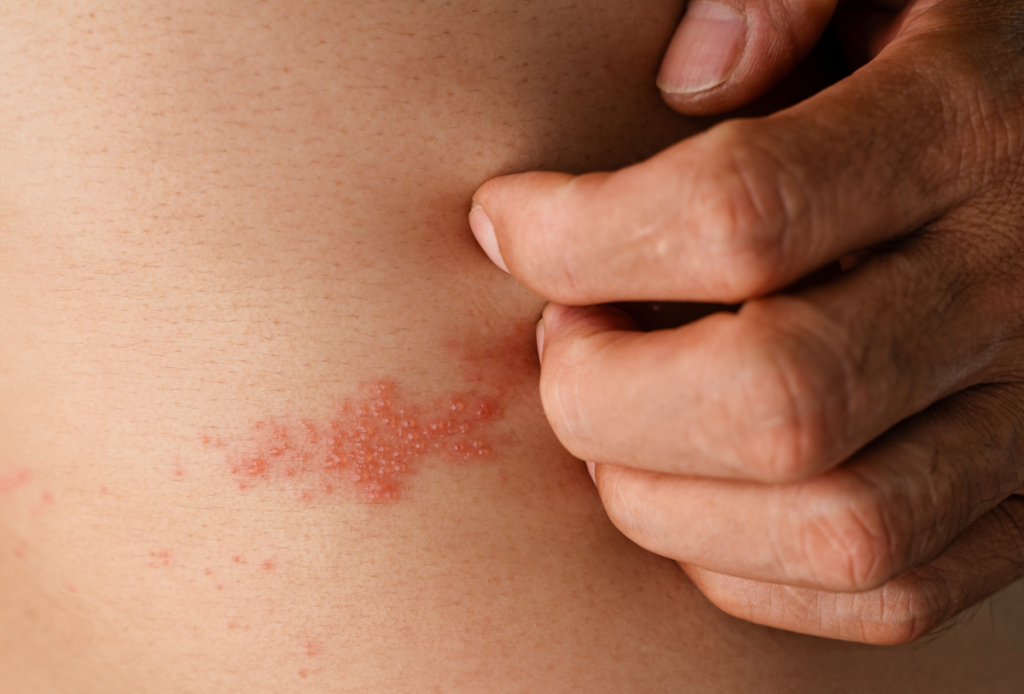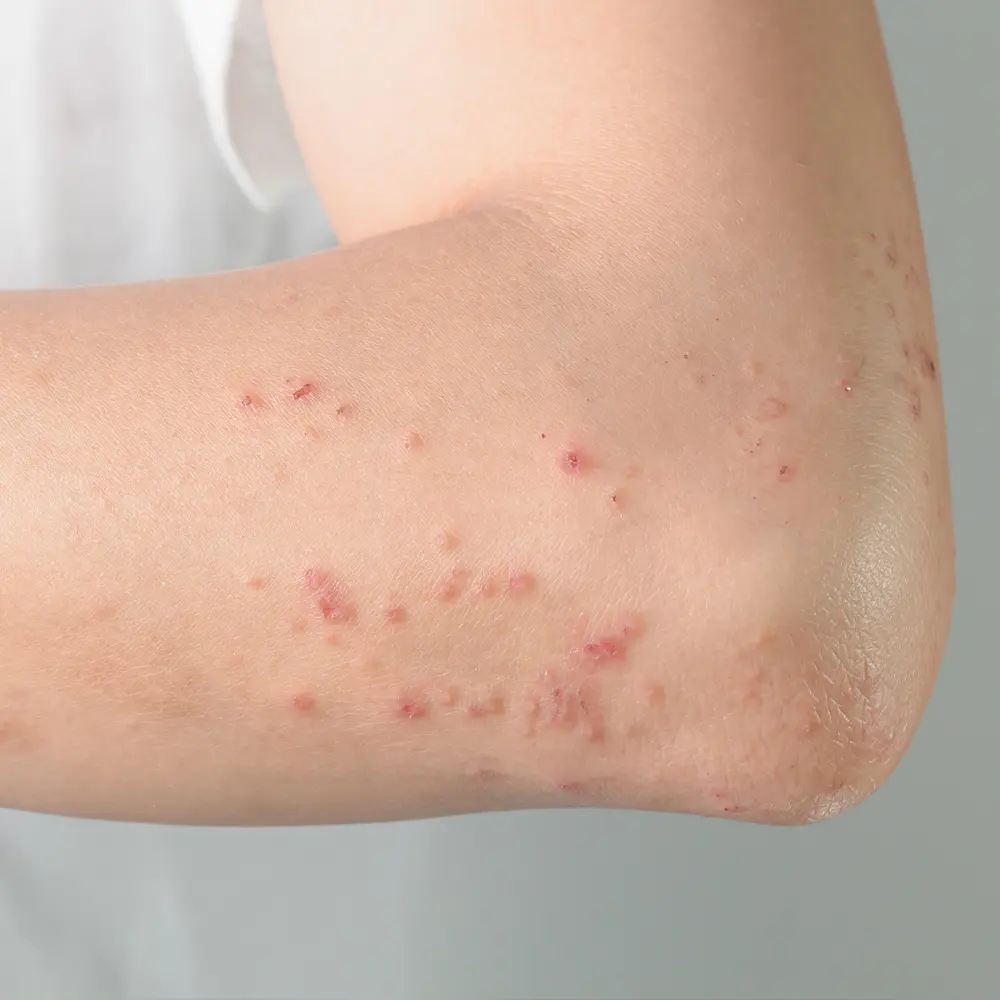A dermatology rash is a visible skin reaction caused by allergies, infections, or conditions like eczema and psoriasis. Diagnosis involves exams, patient history, and tests to identify the exact cause.
Treatment may include creams, antihistamines, or prescriptions, with urgent care needed if symptoms worsen or spread. At DermOnDemand, led by Dr. Hannah Kopelman, patients gain expert care designed to diagnose and treat rashes quickly and effectively. This guide explains causes, types, treatments, and when to seek professional help.
Key Takeaways
- A dermatology rash is a visible skin reaction that may appear as redness, bumps, or scaly patches, and proper diagnosis is key to effective treatment.
- Common causes include allergic skin eruptions, infections, chronic skin conditions like eczema or psoriasis, and acute triggers such as poison ivy or hives.
- Dermatologists use visual exams, patient history, and tests like allergy tests or biopsies to identify the exact cause of a skin rash.
- Treatment options range from over-the-counter creams and oral antihistamines to prescription therapies, with special approaches for children and severe cases.
- Patients should seek medical care if a rash spreads quickly, becomes painful, or is accompanied by fever, and online dermatology services like DermOnDemand provide fast, discreet access to expert treatment.
What Is a Dermatology Rash?
A dermatological rash is a visible skin reaction that may include redness, bumps, or scaly patches on affected areas. It can be temporary or part of a chronic skin condition, and symptoms range from mild irritation to a painful rash. Rashes vary depending on their underlying cause, making proper diagnosis essential.
Key description terms and symptoms
Doctors use terms like “red itchy,” “fluid filled,” or “redness scaly” to describe different rash skin diseases. These descriptions help separate mild irritation from serious conditions. Symptoms may include itchy skin, burning, or tenderness. Some rashes remain localized, while others spread to multiple affected areas.
Pictures of skin rashes (trusted sources)
Pictures of skin rashes, such as those available from the NHS and medical libraries, help patients compare their symptoms. While images can support awareness, they cannot replace a professional exam. Online dermatology ensures that a board-certified dermatologist can match visual clues with medical expertise.
How to Identify a Rash
Identifying a rash involves looking at the pattern, color, and associated symptoms. Some appear as small bumps, others as widespread redness. Because many rashes look alike, patients should avoid self-diagnosis and seek professional input when uncertain.
How to know what rash you have
You can start by asking: Is the rash itchy, painful, or fluid-filled? Did it appear after an allergic reaction or contact with poison ivy? Self-observation helps, but a dermatologist can confirm whether the cause is allergic skin eruptions, infection, or a chronic skin condition.
Tests dermatologists use for rashes.
When identification is unclear, dermatologists may perform an allergy test, a skin biopsy, or lab work. These tests rule out infections, confirm immune system involvement, or detect allergic contact dermatitis. Testing ensures safe and accurate treatment.
When to worry about a rash in adults
Adults should seek immediate care if a rash spreads rapidly, causes fever, or becomes painful. Warning signs include skin irritation that worsens despite home care, blistering, filled patches, or rashes that affect breathing.

Common Causes of Skin Rashes
Most rashes fall into predictable categories. Knowing the cause helps guide effective treatment.
Allergic skin eruptions
An allergic skin eruption often follows exposure to foods, medications, or plants. Contact dermatitis occurs when the skin reacts to allergens like poison ivy or fragrances. The immune system creates a skin reaction, leading to a red, itchy, or blistered rash.
Infections (bacterial, viral, fungal)
Bacterial infections can cause redness scaly patches with pus. Viral infections may trigger a widespread itchy rash. Fungal infections often create itchy skin in moist areas. These causes require targeted medicine for safe recovery.
Chronic skin conditions
Conditions such as psoriasis or eczema are chronic skin conditions. They cause repeated flare-ups, scaling, and long-term skin irritation. Patients often need prescription treatments and ongoing skin care plans.
Hives and localized rashes (e.g., shoulder)
Hives appear as raised, red itchy welts. They often result from an allergic reaction but can also develop from stress or heat. Localized rashes, such as those on the shoulder, may come from irritant contact dermatitis linked to clothing or friction.
Types of Rash Skin Diseases
Dermatologists separate rashes into categories for better treatment.
Eczema rashes and dermatitis
Eczema causes dry, itchy skin and flare-ups of allergic contact dermatitis. Irritant contact dermatitis occurs when soaps or chemicals damage the skin barrier. Both types produce redness scaly patches that may crack.
Psoriasis plaques
Psoriasis is a chronic skin condition marked by raised, red, scaly plaques. It develops when the immune system speeds up skin cell turnover. Psoriasis may affect the scalp, elbows, or knees, often requiring prescription treatment.
Rosacea flare-ups
Rosacea often causes persistent redness on the face. Flare-ups may worsen with sunlight, alcohol, or spicy foods. Unlike an itchy rash, rosacea produces visible blood vessels and facial irritation.
Heat and contact rashes
Heat rashes occur when sweat ducts are blocked, leading to tiny fluid-filled bumps. Contact rashes result from irritant contact dermatitis or an allergic reaction. Examples include poison ivy or reactions to nickel in jewelry.

Treatment Guide for Dermatology Rash
Treatment depends on the underlying cause. Some rashes respond to basic skin care, while others need prescription-grade solutions.
What can a dermatologist do for a rash?
A dermatologist can evaluate affected areas, identify rash skin diseases, and prescribe tailored treatment. At DermOnDemand, board-certified specialists like Dr. Hannah Kopelman provide fast, discreet care without the wait of in-office visits.
Medicines and treatment options for skin rashes
Options include topical creams, oral antihistamines, or antifungal agents. Oral antihistamines reduce itching from allergic skin eruptions. Corticosteroid creams calm immune system reactions. Antibiotics treat bacterial rashes, while antifungals clear yeast infections.
How to treat rashes in children
Children often experience skin irritation from viral infections or allergic contact dermatitis. Safe care includes gentle cleansers, fragrance-free moisturizers, and pediatric-approved oral antihistamines. Parents should seek medical advice if rashes become fluid-filled or painful.
How to get rid of a rash overnight
While complete healing may take longer, temporary relief is possible. Cool compresses, over-the-counter hydrocortisone, or oral antihistamines reduce redness and itchy skin. Proper skin care can calm symptoms until professional treatment begins.
Lifestyle tips and prevention
Preventive skin care reduces recurrence. Key steps include:
- Avoiding known allergens and irritants
- Using mild, fragrance-free cleansers
- Moisturizing daily to prevent dryness
- Scheduling an allergy test when reactions are frequent
When to See a Dermatologist
Some rashes require urgent professional attention.
Urgent signs you shouldn’t ignore
Seek care if a rash spreads quickly, is accompanied by fever, or forms fluid-filled blisters. A painful rash, especially near the eyes, demands immediate medical evaluation.
Benefits of online dermatology care
Online dermatology offers rapid access without waiting rooms. DermOnDemand provides tailored treatment reviewed by a board-certified dermatologist in under 24 hours. Patients receive discreet, prescription-grade solutions delivered to their home.
Start Your Online Dermatology Plan
If you have a skin rash that persists or worsens, professional evaluation is the safest step. With DermOnDemand, you can complete a secure form in minutes, and Dr. Hannah Kopelman or another board-certified dermatologist will review your case. Start your online dermatology plan today for fast, discreet, and expert care.








